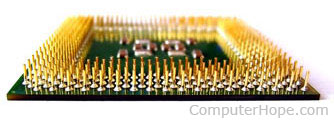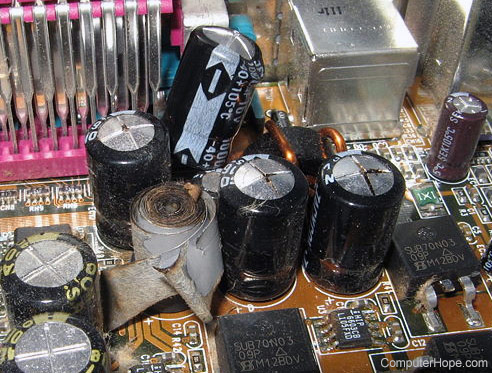How to test a computer motherboard and CPU for failures

A bad computer motherboard or CPU (central processing unit) can cause an assortment of problems on your computer. There are different ways to test and troubleshoot your computer's motherboard and CPU to determine if it's bad or has flaws. Below are some possible issues you may encounter. It is important to remember that they can also be caused by faulty parts other than a bad motherboard or CPU.
- Computer does not boot, instead you get a beep code.
- Computer turns on, but no display on the monitor.
- Random computer crashes causing general protection fault error messages, illegal operations, or fatal exceptions, etc.
- Computer randomly reboots.
Visual hardware check
The first thing to do is perform a visual inspection of the motherboard. A common cause of motherboard issues or failure is bulged or blown capacitors. Check the top of each capacitor to see if it's bulging or leaking, as these conditions indicate that a capacitor is broken. If you find any bulging or blown capacitors, that's very likely causing computer motherboard problems.

For the CPU, a visual check requires you to remove the CPU from the computer. Once the CPU is removed, check for bent pins on the side that is inserted in the motherboard. If you find a bent pin, that's likely causing issues with the CPU and computer.
It may be possible to replace a bulging or blown capacitor, but precision soldering is required to install a new capacitor. Bent pins on a CPU can be bent back into place, but very carefully. A pin can break off when trying to bend it back, and if that happens, the CPU needs to be replaced.
If your inspection yields no obvious visible issues, use a software utility or hardware tool to diagnose the problem.
Software and hardware solutions
Below are programs designed to test your computer's motherboard and CPU. However, with the complexity and wide variety of these hardware components, programs may not detect every possible failure.
- HWiNFO - A great program to view hardware details and monitor the hardware for failures, and is free for personal use.
- Intel Processor Diagnostic Tool - If you have an Intel processor, the Intel Processor Diagnostic Tool is a great free utility for testing many Intel processors.
There are also some excellent hardware tools for testing and diagnosing motherboards and CPUs. Below are a few of these tools.
- PC-Doctor - A fantastic, but not cheap, solution used for service centers and technicians to diagnose computer hardware issues, including those that relate to motherboards.
- Ultra-X - Another great collection of products to test computer hardware, including the motherboard.
Replace the motherboard and CPU
If the tools listed above for testing the motherboard or CPU show that one or both are bad, then replace them. Unfortunately, there is no easy or cheap way to fix these components.
If the bad motherboard or CPU is in a laptop, you likely need to take your laptop to a licensed computer repair shop for help. Trying to replace the motherboard or CPU yourself may void the laptop warranty.
If you have not tried a software or hardware tool to analyze the motherboard or CPU, you may want to take your computer to a repair shop. Be aware that they may also recommend replacing the motherboard or CPU if they find one or both to be defective.
